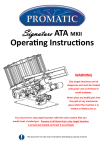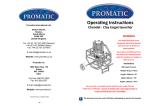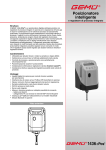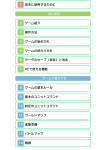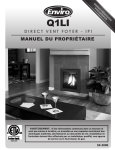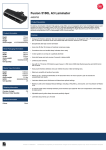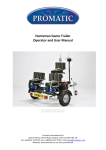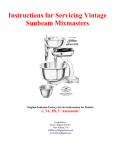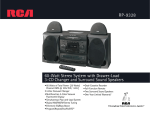Download Operating Instructions
Transcript
Promatic International Ltd. Station Works, Hooton, South Wirral CH66 7NF, United Kingdom. Operating Instructions Osprey - Clay target launcher Tel: +44 (0) 151 327 2220 (General) +44 (0) 1407 860800 (Sales) Fax: +44 (0) 151 3277075 E-mail [email protected] Website: www.promatic.co.uk WARNING Promatic Inc. Clay target launchers can be dangerous and must be treated with great care at all times to avoid accidents. 7803 West Hwy 116 Gower MO 64454 USA. Toll Free: 888.767.2529 Fax: 816.539.0257 Never place any bodily part into the path of any mechanical piece whilst the machine is in motion or likely to be so. E-mail: [email protected] Website: www.promatic.biz You must treat a clay target launcher with the same caution that you would treat a loaded gun. Assume at all times that a clay target launcher is armed and loaded and treat it accordingly Osprey Version 16 1.0 — March 2015 This document must be read in full before attempting to operate the machine Preface: Every effort has been made to ensure that the information contained within this manual is complete, accurate and up-to-date. Promatic International assumes no responsibility for errors beyond its control. Conventions used within this manual: Trap: Your Osprey - Clay target launcher - commonly known as a clay trap and may be referred to in this manual as “The trap” or “The machine” Warnings & Cautions: Warning: This section contains instructions which, if ignored or carried out incorrectly, may result in risk of personal injury. Caution: This section contains instructions which, if ignored or carried out incorrectly, may result in malfunction or damage to the equipment or consumables. Note: This section contains additional information which the user may find useful, but is not essential to the operation of the product. 12v DC Power Source: This Trap is designed to be powered from a 12v DC battery. IT MUST NEVER BE DIRECTLY CONNECTED TO HOUSEHOLD AC POWER Battery: Where a trap is connected to any other suitable power source i.e. a Transformer - the relevant sections of instructions should still be observed, i.e. “Disconnect the battery” and applied to this or any other power source. EYE PROTECTION MUST BE WORN WHEN WORKING ON OR AROUND A CLAY TARGET LAUNCHER AS SMALL SHARP PIECES OF CLAY MAY BE EJECTED DURING NORMAL USE. 2 15 Spare Parts For parts not listed please call Promatic or you local dealer / service agent or visit www.promatic.co.uk Specifications: Trap on Extreme tilt base Arm Clamp Block SP/2500 Motor-gear unit M01V/63923 Arm assembly SP/2010 Gearbox clamp block RN6/4150 Friction Strip RN6/2200 Clay Sweeper A28A/PAGG Carousel: 300 Birds Length: 983mm 38 3/4” (Arm Extended) Width: 874mm 34 1/2” Height: 1078mm 42 1/2” Short Hook Trap Spring S01Z/SHTR Let Down Ramp (6 stack) RN6/3400 (8 stack) SP/3400 Soft Fall Plate A28F/PAJJ Outer Knife-edge A28S/AKIU Back Rail SP/3440 Rubber Buffer (Clay Stop) D06L/1566 Inner Knife-edge (6 stack machines) A28S/ANRY Inner Knife-edge (8 stack machines) A28S/AWCA GENERAL WARNINGS - BEFORE OPERATING ANY TRAP Quick Battery Terminal Clamp Positive (Red) E06V/45100 Negative (Blue) E06V/45110 5 pin relay E09V/5PIN 5 amp fuse E10V/F05A 40 amp fuse E10V/F40A Toggle switch E11V/7430 Roller switch RN6/7200 14 Trip Switch (50a ) E10V/MB50A 12v Command cable E03V/CCCH ALWAYS disarm the machine before any loading, adjustment or maintenance. ALWAYS load clays from rear and ONLY if the machine is disarmed and safe. NEVER approach the machine from the front or sides. ALWAYS from the rear. NEVER allow children or untrained persons to approach or touch the machine. NEVER move an armed/loaded machine. ALWAYS disarm and disconnect battery. REMOVE the main throwing spring before transport in a vehicle. BE AWARE of the fall zone of both broken and unbroken clays and that a change in wind direction will affect this. 3 Understanding your new trap: 4. Machine arms, but will not fire on command cable button. (a) Either the connections, cable or command push button are faulty. Disconnect the Hirschmann connector from the control box socket and using a short piece of wire connect pins 2 & 3 in the socket (do not put anything into the other pin holes as one of these carries continuous +12v for radio use.) Roller Switch If the trap does not fire then there is a broken wire in the cable or a bad connection within the Hirschmann connector or control box. Throwing Arm (b) If the trap does fire then reconnect the command cable, remove the cover on the push button box and short across the two spade connectors. If the trap fires - then the push button is faulty. If the trap does not fire - then there is a broken wire in the command cable or a bad connection in the connector. 5. Trap fires by itself! (a) Disconnect the command cable and switch the trap back on. If the trap re-arms normally - then the command cable is damaged or shorted out. Alternatively, the push button switch is stuck in or faulty. (b) If the trap continues to fire - then check the arm to crank timing relationship as described on page 13 of this manual. If this relationship is correct then, after having put the trap into the disarmed/safe position, move the roller limit switch out along the slotted bracket to its maximum. If the machine now re-arms normally - then move the limit switch back to within 5mm of its original position. If the trap now fires by itself again then move the switch to 10mm of its original position and so on until the trap arms normally under all conditions. Main Shaft Gearbox block Spring Spring Adjustment Nut Cocking Motor Let down ramp Carousel Knife edges Casting Plate Rear Pusher Tilt Adjustment Elevation Adjust- 4 ALWAYS disarm the machine before any loading, adjustment or maintenance. ALWAYS load clays from rear and ONLY if the machine is disarmed and safe. NEVER approach the machine from the front or sides. ALWAYS from the rear. NEVER allow children or untrained persons to approach or touch the machine. NEVER move an armed/loaded machine. ALWAYS disarm and disconnect battery. REMOVE the main throwing spring before Transport in a vehicle. BE AWARE of the fall zone of both broken and unbroken clays and that a change in wind direction will affect this. 13 ALWAYS disarm the machine before carrying out loading, adjustment or maintenance. Troubleshooting: 1. Machine does not arm (i.e. come to the loaded position). (a) Check the battery is charged and that connections are tight. (b) Check the toggle switch is in the down (ON) position. (c) 2. Check the Throwing arm is clear of the Roller switch under the Casting plate. If not, then press toggle up to nudge the Arm around until it is clear, then switch it back down to the ON position. Machine still does not arm. Connecting the battery: Ensure you are behind the machine, that the ARM/DISARM switch is in the OFF position and the trap in a safe condition (either disarmed or in safe mode). Connect the red cable to the Red (+) terminal and the black cable to the Black (-) Terminal. Ensure the terminal fasteners are tight, the battery is safely positioned and the charger has been removed. Never approach the machine from the front or sides, Do not assume the trap is safe, even without electrical power it may still be armed and can fire without power being applied. (a) Check all connections are tight including those inside the electrical box. Check for broken wires and damaged connections. Battery Troubleshooting : (b) If there are no broken connections (battery connected, all switches on) press toggle up to “NUDGE”, listen and watch for the 12v relay operation in the control box. (c) If the relay operates but the motor does not turn - momentarily short across the 2 large contacts on the relay with a screw driver or piece of wire. (These are the two terminals with red wires connected to them). If the motor does not turn - then the motor is suspect. If the motor does turn - then the relay is faulty. Contacts may be dirty or worn out. Trap fails to re-arm - If after a period of prolonged use the trap fails to re-arm itself and is found to be stalled (may also be making a humming sound) then this is an indication that the battery is depleted, and the voltage has fallen too low to operate the trap. Disconnect the battery immediately and re-charge (or fit a replacement fullycharged battery). (d) If the relay does not operate – check the fuse has not blown. Replace fuse if it has blown and try again. (e) If the motor does not turn - then short the brown wire to the yellow/green wire on the back of the toggle switch with the switch in the “NUDGE” position. If the relay operates and the motor turns then the toggle switch is faulty. If the relay still does not operate, then it’s the relay that is faulty. 3. Machine runs in “NUDGE” position, but not in “ON” position. If the arm is clear of the Roller Switch then the Roller Switch may be faulty. Check that the roller arm is not seized. If so, strip, clean and re-assemble. Otherwise replace the Roller Switch. 12 Although the battery may appear to have recovered, the trap should not be used any further than necessary to make it safe as continued operation at low voltage may cause damage to the motor, Battery or other electrical components. Circuit breaker has operated - The battery may have been incorrectly fitted (terminals reversed) or an excessive amount of current was drawn either due to a fault or obstruction within the trap. If the circuit breaker has tripped due to an obstruction DO NOT ASSUME THE TRAP IS SAFE it may still be armed with the obstruction holding back the energy from the spring - carefully clear the obstruction whilst remaining in the safe area behind the trap BE AWARE of the path of the throwing arm AND the debris that may be ejected. 5 Transit Mode Procedure - This is recommended for machine transportation. Warning: Stand at rear of machine only 1. Disarm the machine by flicking the ARM/DISARM switch momentarily towards the DISARM position and immediately releasing (long enough for the trap to fire, but not giving the machine a chance to rearm). The throwing arm should be pointing towards the front of the machine. The Gearbox block (A rectangular block attached to the gearbox shaft) should be in a position pointing towards the front of the machine. Push the ARM/DISARM switch momentarily in direction of DISARM/NUDGE just enough to allow the block to move slightly past the straight ahead position as seen in the diagram below. If the block has gone too far, follow this procedure again until the desired position is achieved. 2. Disconnect the power source from the machine. 3. Adjust the spring to reduce the tension. 4. The throwing arm can be pushed slowly, USING THE PALM OF THE HAND ONLY, around Anti-clockwise (Into the machine). Mainshaft pin locked against Drive pin. Adjustment: Throwing arm timing 1. Disarm the machine by flicking the ARM/DISARM switch upwards towards the DISARM position and immediately releasing (long enough for the trap to fire, but not giving the machine a chance to rearm). The gearbox block will now be pointing towards the front of the machine. 2. Flick the ARM/DISARM switch upwards towards the DISARM position repeatedly until the gearbox block points towards the back of the machine but does not contact the throwing arm. This reduces the spring tension. 3. Note the position of the inside nut before removing the spring (as this determines the amount of spring tension set) then undo the rear nut and remove the spring from the trap. 4. With the spring removed, rotate the throwing arm until the mainshaft crank is pointing towards the mainframe with the leading curve aligned with the front edge of the square bearing tube. Refer to the diagram below. 5. Loosen the throwing arm clamp block bolt until the throwing arm will move around the mainshaft. Rotate the throwing arm clockwise (this is so the mainshaft is held by the one-way bearing and doesn’t move) until the throwing arm is positioned as in the diagram below, where X=15mm. 6. Making sure both the mainshaft crank and the throwing arm are in the positions described and that the mainshaft crank has not dropped or the throwing arm has lifted, firmly tighten the throwing arm clamp block bolt. The arm timing is now complete. Check there are no gaps either side of the bearing tube. 7. Replace the spring paying attention to the orientation of the hook (Open side inwards towards the frame). Throwing arm pushed into machine Mainshaft pin Drive pin Gearbox block Direction of rotation 6 11 ALWAYS disarm the machine before carrying out loading, adjustment or maintenance. 5. As the throwing arm gets to the firing position (pointing directly to the back of the machine) the spring will take over, moving the arm onto the drive bolt on the Gearbox block. This will stop the arm and prevent it from firing. 6. This is TRANSIT MODE. The arm is now locked between the drive bolt and the one-way bearing within the trap, it cannot move or release again until power is applied and the ARM/DISARM switch operated. Adjustment: Spring Tension Spring adjustment is always easier if the spring roller on the main shaft is at its rearmost position, this relieves the spring of a large proportion of it’s tension making adjustment much easier as well as reducing wear on the spring adjustment mechanism. To achieve this, first perform the Safe Mode Procedure (see page 7/8) to put the machine into safe mode and then nudge forward until the throwing arm projects forward from the front of the machine. At this point stop nudging and disconnect the battery. Loosen the spring adjustment nut. To increase the spring tension, move the Lock nut towards the coil spring and then tighten the Adjustment nut behind it. To reduce the spring tension, move the Adjustment nut away from the spring coil and tighten the lock nut behind it. Adjustment nut Disarming the machine (Safe mode). 1. 2. Firing the machine (Ensure the range is clear at the front of the trap.) 1. 2. 3. Spring To disarm the machine push the ARM/DISARM switch momentarily to the DISARM position and immediately release (long enough for the trap to fire, but not giving the machine a chance to rearm). The throwing arm should be pointing towards the front of the machine. Turn the ON/OFF or switch (if fitted) to the OFF or position and disconnect the battery. Turn the ON/OFF or switch (if fitted) to the ON or position and set the ARM/DISARM switch to the ARM/LOAD position. The machine will move automatically and arm itself ready to launch a loaded clay. Press the FIRE button on the command cable to throw a clay. The machine will fire every time the FIRE button is pressed and will automatically rearm itself, until disarmed and switched off. When switched off, disconnect the power source. Lock nut Positioning the machine Important: leave 30mm (1 3/16”) thread length between inside nut and spring coil. Increasing spring tension up to full length of thread will seriously detriment the performance of the machine and will cause spring damage or failure. 10 1. 2. 3. Clay Target Launchers must be situated on firm level ground in a position that will allow unrestricted access to rear of machine. There must be no obstructions to the path of the throwing arm. Ensure that the power supply can be easily disconnected and cables cannot become tangled in any part of the mechanism. 7 Tilt Adjustment: Adjustment: Setting up knife edges On Osprey models fitted with the extreme tilt base, the machine may be tilted to either side to achieve either curling or flat targets. Refer to the diagram below. Place a clay target on the top plate and slide it half way under the two knife edges. Using a 10mm spanner/wrench, adjust the height of the inner and outer leading edge of each blade (Position A in bottom diagram). It is desirable to have no less than 0.5mm clearance between the underside of the knife blades and the horizontal shoulder of the clay. It is also important that the knife edges have the correct clearance around the diameter of the clay and that they support the skirt of the clay resting on the knife edges for its entire travel along the knife edge. To set this, hold the clay against the inner two carousel bars and gently tap the inner knife edge until there is approximately 1mm clearance between the dome of the clay and the knife edge. Tighten fixing bolts. Now hold the clay against the two outer carousel bars. Again gently tap the outer knife edge until there is approx. 1mm clearance between the dome of the clay and the knife edge. Tighten fixing bolts. To make elevation changes, loosen the Elevation lock bolt on the side of the trap. Pull the Elevation plunger to disengage the pin from the adjustment hole in the base upright and move the trap to the desired height. Relocate the plunger fully into the new adjustment hole. Ensure the trap is supported whilst making adjustments. Retighten the Elevation lock nut. To make tilt changes, loosen the Tilt lock nut located on the front of the base. Pull the Tilt adjustment plunger to disengage the pin from the adjustment hole on the end of the base upright and move the trap to the desired angle. Ensure the trap is supported whilst making adjustments. Relocate the plunger fully into the new adjustment hole. Retighten the Tilt lock bolt. Elevation adjustment plunger Elevation lock bolt Tilt adjustment bolt (at front) Tilt adjustment plunger Outer carousel bars Inner carousel bars A A Support the weight of the machine from the top of the carousel (or have an assistant do this) and then gently lean the machine in the desired direction, so that it does not fall suddenly whilst making the adjustment. 8 9









